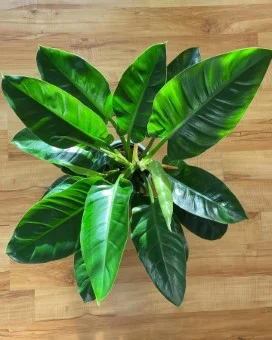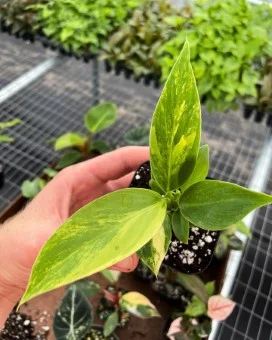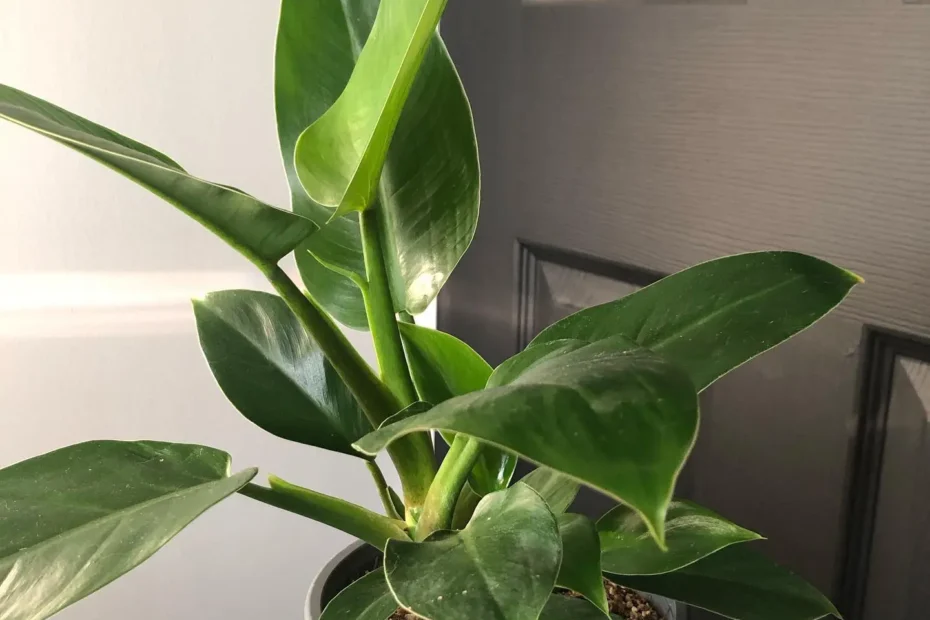Introduction
Imagine strolling through a dense tropical forest, the air thick with humidity, when suddenly, a vibrant splash of green catches your eye. Towering above the underbrush stands the majestic Philodendron Imperial Green, its glossy, broad leaves reflecting the dappled sunlight. This captivating plant, with its rich color and elegant stature, could easily be the crowning jewel of any indoor garden.
Yet, many enthusiasts find themselves puzzled, struggling to replicate the lush, vibrant growth seen in their natural habitat. The challenges of providing adequate light, the right amount of water, and perfect humidity levels can make it seem like an enigma wrapped in a green mystery.
Fear not, fellow plant lovers! I, a passionate botanist with years of experience tending to these emerald beauties, have navigated the tricky waters of Philodendron Imperial Green care. In the pages that follow, I promise to unveil a comprehensive guide, tailored to help you cultivate a thriving, breathtaking specimen. Together, we’ll transform the enigmatic into the attainable, ensuring your Philodendron not only survives but flourishes, becoming a testament to the joys of plant parenthood.
Unveiling the Philodendron Imperial Green
Botanical Background
The Philodendron Imperial Green, scientifically known as Philodendron Erubescens ‘Imperial Green’, is a stunning cultivar of the Philodendron Erubescens, a species famed for its remarkable adaptability and allure. Originating from the tropical rainforests of South America, this plant has evolved to thrive under the canopy of towering trees, where dappled sunlight and humid air are in abundance. The ‘Imperial Green’ variety, with its lush, vibrant leaves, captures the essence of its exotic origins, bringing a piece of the tropics into our homes.
Unlike some of its Philodendron cousins, which may feature striking colors or variegation, the Imperial Green showcases pure, deep green foliage, earning it a cherished spot in the hearts of minimalistic and contemporary gardeners alike. Its resilience and relatively low maintenance requirements further contribute to its popularity among indoor plant enthusiasts.
Key Characteristics
The Philodendron Imperial Green is immediately recognizable by its large, glossy leaves. The foliage of this plant is not only a visual treat but also feels slightly textured to the touch, adding a tactile dimension to its appeal. These leaves can grow quite substantial in size, creating an eye-catching display of verdant splendor that can liven up any space.
In its natural habitat, the Philodendron Imperial Green exhibits a climbing nature, utilizing aerial roots to anchor itself to larger trees as it reaches for the canopy. This climbing tendency can be mimicked indoors with the use of moss poles or trellises, encouraging vertical growth and adding an intriguing structural element to your indoor garden.
Beyond its aesthetic contribution, the Philodendron Imperial Green is also celebrated for its air-purifying qualities. It has been noted for its ability to absorb pollutants and purify the air, making it not just a decorative plant, but a functional addition to any home seeking a healthier, greener environment.
Essential Care Requirements Philodendron Imperial Green
Lighting Needs
One of the critical elements in nurturing a thriving Philodendron Imperial Green is understanding its need for bright, indirect sunlight. Direct exposure to intense sunlight can lead to scorched, discolored leaves, robbing this plant of its vibrant green luster. To find the sweet spot for your Philodendron, consider placing it near an east-facing window where it can bask in the gentle morning light.
Utilizing sheer curtains to diffuse harsh rays can further help control the amount of sunlight reaching the plant, ensuring it receives just the right amount of light without the harmful effects of direct sun.
Watering Wisdom
The Philodendron Imperial Green thrives on a “wait and see” approach to watering. Before reaching for the watering can, check the top 1-2 inches of the soil for dryness. If the soil feels dry to the touch, it’s time to water thoroughly, allowing excess water to drain freely.
This practice helps prevent both overwatering and underwatering—common pitfalls that can lead to root rot or dehydrated, drooping leaves. Regular checks and a consistent watering schedule tailored to your plant’s environment will keep your Philodendron hydrated and healthy.
Soil Secrets
A well-draining potting mix is non-negotiable for the health and happiness of your Philodendron Imperial Green. An aroid mix, characterized by its excellent drainage and airiness, provides the perfect environment for Philodendron roots to thrive.
You can either create your own mix using orchid bark, perlite, and peat moss in equal parts, or opt for a reputable pre-mixed aroid potting mix available at garden centers. Such soil ensures that water flows freely, preventing waterlogging while providing enough organic matter to support robust growth.
Humidity Haven
Philodendron Imperial Green’s tropical lineage instills a love for moderate to high humidity levels, creating a demand for a moist environment akin to its natural rainforest habitat. Achieving this indoors might seem daunting, but with a few tricks, your home can become a humidity haven.
Solutions such as placing your plant on a pebble tray with water, employing a humidifier, or grouping plants together can significantly increase the ambient humidity around your philodendron. These methods help simulate a more tropical atmosphere, promoting lush, healthy foliage and capturing the essence of its native environment.
Philodendron Imperial Green Pro Tips for Optimal Growth


Fertilizing Frenzy
To ensure your Philodendron Imperial Green receives all the nutrients it requires for optimal growth, incorporating a balanced, slow-release fertilizer suitable for aroids into your care routine is essential, especially during the vigorous growing seasons of spring and summer. Look for fertilizers with an equal ratio of nitrogen, phosphorus, and potassium (NPK), as this balance supports both the lush foliage and root development of the plant.
It’s crucial to follow the package instructions for dilution and application frequency, as over-fertilizing can harm your plant more than help it. Applying diluted fertilizer once a month during these active growth periods will contribute to a visibly healthier and more vibrant Philodendron.
Climbing Companions
Given its climbing nature in the wild, integrating a moss pole or a coir pole into your Philodendron Imperial Green’s pot can significantly benefit its growth and mimic its natural climbing tendencies. These poles not only support aerial root attachment but also encourage the plant to grow taller and more robust. When installing a moss or coir pole, ensure it’s securely placed deep into the potting mix and adjacent to the plant’s main stem.
Gently tie the plant’s stem to the pole using soft plant ties or old pantyhose cut into strips, allowing the aerial roots to make contact with the pole. Over time, as the plant grows, continue to attach new growth to the pole, promoting an upward growth pattern which can lead to a more dramatic and natural display.
Propagation Prowess
One effective and satisfying method of propagating your Philodendron Imperial Green is through water propagation. This method involves taking a healthy stem cutting from your plant, ensuring it has at least two to three leaves and one or two nodes (the small bumps on the stem where leaves and roots grow). Here’s a step-by-step guide:
- With a clean, sharp knife or scissors, cut a section of the stem just below a node.
- Remove the lower leaves to expose the node(s) fully.
- Place the cutting in a jar or container filled with room temperature water, making sure the node(s) are submerged while the leaves remain above water.
- Position the container in a location with bright, indirect light, and change the water every few days to keep it fresh.
- In a few weeks, roots should begin to emerge from the nodes. Once the roots are a few inches long, the cutting is ready to be transplanted into a pot with well-draining soil.
This straightforward method not only allows you to expand your indoor garden but also to share the joy of Philodendron Imperial Green with friends and family. Happy planting!
Philodendron Imperial Green Troubleshooting Common Issues
Brown Leaves: Causes and Solutions
Brown leaves on your Philodendron Imperial Green can be alarming, but understanding the cause is the first step to reviving your plant. Excessive sunlight is a common culprit, leading to scorched leaves. To remedy this, relocate your plant to an area with bright, indirect light. Underwatering can also result in brown, crispy leaf edges.
Increase watering frequency, ensuring the top 1-2 inches of soil are moist but not soggy. Incorrect fertilization, specifically over-fertilization, can cause nutrient burn, manifesting as brown spots on leaves. Use a balanced, slow-release fertilizer and closely follow the recommended application rates to avoid this issue.
Pests and Diseases
Pests such as mealybugs and fungal gnats can threaten your Philodendron’s health. Mealybugs appear as tiny white cotton-like masses on the leaves and stems, while fungal gnats are small, dark-colored flies seen around the soil. For organic control, neem oil is an effective treatment for mealybugs when applied directly to the affected areas.
Fungal gnats can be controlled by reducing watering to allow the top layer of soil to dry, creating an inhospitable environment for gnat larvae. Preventative measures include regular inspection of your plant for early signs of pests and ensuring good air circulation around your Philodendron to reduce the risk of disease.
Conclusion
Caring for a Philodendron Imperial Green rewards you with lush, tropical foliage that can brighten any indoor space. Remember, the key to a healthy plant lies in providing well-draining soil, maintaining moderate to high humidity, ensuring bright, indirect light, and using a balanced fertilizer during growing seasons. Also, don’t forget to support its climbing habit with a moss or coir pole and explore water propagation to expand or share your collection. Your commitment to these care practices will result in a thriving Philodendron that embodies the essence of its rainforest origins.
We’re excited to see your Philodendron Imperial Green flourish in its home environment. Share your plant’s growth, your propagation successes, or any care tips you’ve discovered along the way in the comments below or on social media using the hashtag #GreenImperialJourney. Your experiences not only celebrate your green thumb achievements but also help inspire and educate fellow plant enthusiasts in our community. Happy planting!
Additional Tips
## Visual Appeal and Engaging Connection
Incorporating high-quality photos of Philodendron Imperial Green at various stages of growth truly brings this care guide to life. Witnessing the transformation of a young plant into a sprawling green masterpiece can inspire and excite even the most novice of plant enthusiasts. From its early days as a modest potted plant to becoming a statement piece in a room, each photo serves as a testament to the rewards of diligent care and attention.
For those just starting their indoor plant collection, consider reading our blog post on Best Indoor Plants for Beginners. It’s a treasure trove of easy-to-care-for plants that can make your home feel closer to nature without overwhelming you with complex requirements. Similarly, our article on Creating a Humid Indoor Environment offers effective tips for ensuring your tropical plants, including your Philodendron Imperial Green, feel right at home.
Through my own experience, monitoring the growth and responding to the needs of a Philodendron Imperial Green has been a rewarding journey. There were moments of trial and error, especially when it came to finding the perfect spot in my home that provided just the right amount of indirect light. But seeing a new leaf unfurl, vibrant and healthy, is an unmatched delight. It’s these small victories that underscore the beauty of indoor gardening – a continuous learning experience that nurtures both plant and caretaker.
In the spirit of sharing and community, we encourage you to share your photos and stories of your Philodendron Imperial Green. Whether it’s a milestone in its growth or a tip you found particularly helpful, your insights enrich our collective knowledge and passion for plant care. Post your experiences in the comments below or tag us on social media with #GreenImperialJourney. Together, we’re cultivating not just plants, but a vibrant community of plant lovers. Happy planting!
